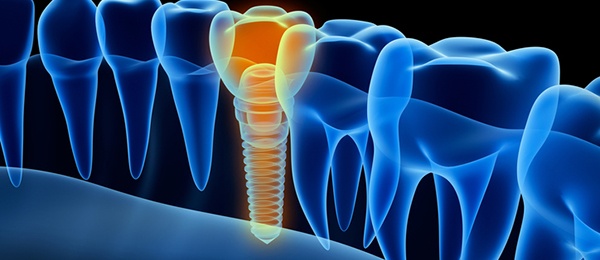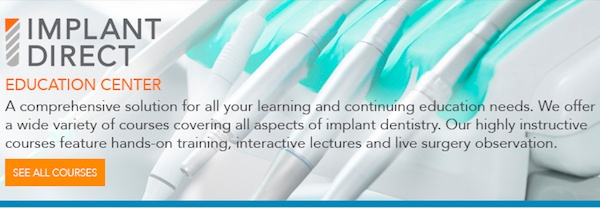What's in this issue?A classification for peri-implant diseases and conditions >>A systematic review of peri-implantitis prevalence, incidence, and risk factors >>Assessing the midfacial mucosal outcome around final restorations: an 8-year follow-up >> Product Spotlight: Implantology CE courses >>News You Can Use:One more week to submit your abstracts for AO 2019 >>News You Can Use:Register for a variety of implant dentistry courses at ADA 2018! >> |
Esthetics of natural teeth before extraction versus final implant restorations
Esthetic outcomes are an essential aspect of implant dentistry. Researchers conducted a study to compare natural teeth in esthetic regions before extraction with the final implant restorations. They proposed a new esthetic index based on the natural dentition (EIND). The study was published in the July/August issue of The International Journal of Oral & Maxillofacial Implants.
The study included 51 patients (35 women, 16 men) with a high smile line who were referred to the Department of Periodontology at Hacettepe University in Ankara, Turkey, for implant treatment. Participants ranged in age from 18 through 64 years, with a mean (standard deviation [SD]) age of 39.6 (12.2) years. The patients received 83 implants in the maxillary anterior region. Of the 83 implants, 67 (80.7%) were placed immediately after tooth extraction, and 16 (19.3%) were placed a mean of 4 months after extraction.
Intraoral photographs and periapical digital radiographs were obtained from all patients before tooth extraction and at a mean (SD) of 10.4 (1.5) months after delivery of implant-supported permanent restorations.
The researchers made the following measurements:
- pink esthetic score (PES) (range, 0-2): mesial papilla, distal papilla, soft-tissue margin level, soft-tissue contour, alveolar process, soft-tissue color, and soft-tissue texture;
- tissue biotype;
- keratinized mucosa (KM);
- interproximal bone level;
- relationship to the adjacent dentition or dental implant.
In addition, they obtained the following measurements for the implant only:
- horizontal dental implant position;
- buccal plate thickness;
- vertical position;
- surgical procedures;
- implant procedures;
- prosthetic design;
- implant design;
- implant neck level;
- dental implant length and width.
The statistical analyses showed significant differences between the tooth sites and implant sites in tissue contour (P = .001) and texture (P = .001), alveolar deficiency (P = .001), and total PES (P = .007). The remaining soft-tissue parameters did not exhibit statistically significant differences between tooth and implant sites, the authors wrote.
The researchers conducted further analyses of associations between several parameters (PES, tissue biotype, and KM) and related indexes. Mesial papilla, distal papilla, margin level, alveolar deficiency, and KM exhibited statistically significant associations with interproximal bone level before and after tooth extraction. However, tissue contour, color, and texture exhibited significant associations with interproximal bone level only before extraction. Tissue biotype was not associated with interproximal bone level before or after extraction, but it did exhibit a significant association with buccal bone thickness, prosthetic design, and use of surgical procedures (such as soft-tissue grafting or bone regenerative procedures).
The study findings also revealed an association between horizontal implant position and tissue margin and alveolar deficiency. In addition, vertical implant position was associated with tissue contour and alveolar deficiency. Buccal bone thickness was associated with tissue contour and color. Furthermore, the use of a connective tissue graft during or after implant placement was associated significantly with a higher value for mesial papilla appearance.
The second objective of this study was to propose an EIND—a combination of modified PES and hard-issue analyses—for clinicians to use during pre-extraction treatment planning to evaluate esthetic-related parameters and assess the risk of experiencing unesthetic outcomes. Scores on the EIND range from 0 to 2 (for example, mesial papilla is a comparison of shape with that of the reference tooth: 0 = absent; 1 = incomplete; 2 = complete).
The researchers concluded that implant-supported restorations exhibited better esthetics than the natural teeth they replaced.
A classification for peri-implant diseases and conditions
The 2017 Workshop on the Classification of Periodontal and Peri-Implant Diseases and Conditions, conducted jointly by the American Academy of Periodontology and the European Federation of Periodontology, published reports from several workgroups. Their consensus report, which was published in a supplement to the June 21 issue of Journal of Periodontology, presents a classification for peri-implant diseases and conditions.
Participants in this workshop developed questions and case definitions for situations in which a clinician has reason to believe that biofilms on implant surfaces are the primary etiologic exposures associated with the development of peri-implant mucositis or peri-implantitis. The authors stressed that major patient-specific differences exist with respect to inflammatory responses to microbial challenges. In preparing this consensus report, they assumed that implants were placed properly and integrated with soft and hard tissues.
According to the consensus report, the main clinical characteristic of peri-implant mucositis is bleeding on gentle probing. In addition, erythema, swelling, or suppuration may be present. Owing to swelling or a decrease in probing resistance, an increase in probing depth (PD) often is observed in the presence of peri-implant mucositis. Strong evidence from animal and human studies indicates that plaque is the etiologic factor for peri-implant mucositis. Smoking, diabetes mellitus, and radiation therapy may modify the condition.
The authors described peri-implantitis as a plaque-associated pathologic condition occurring in tissues around dental implants. It is characterized by inflammation in the peri-implant mucosa and subsequent progressive loss of supporting bone. Peri-implantitis sites exhibit clinical signs of inflammation, bleeding on probing, or suppuration; increased PDs (≥ 6 millimeters) or recession of the mucosal margin; and radiographic bone loss. PD is correlated with bone loss at peri-implantitis sites and, hence, is an indicator of disease severity. However, the authors point out that the rate of bone loss progression may vary among patients.
Observational studies indicate that patients with a history of severe periodontitis, as well as those who exhibit poor plaque control and do not receive regular maintenance therapy, are at increased risk of developing peri-implantitis. Study findings also reveal that anti-infective treatment strategies decrease soft-tissue inflammation and suppress disease progression.
Limited evidence links peri-implantitis to postrestorative presence of submucosal cement and implant positioning that does not facilitate good oral hygiene. However, the role of peri-implant keratinized mucosa, occlusal overload, titanium particles, bone compression necrosis, overheating, micromotion, and biocorrosion as risk indicators for peri-implantitis remains to be determined.
The authors introduced case definitions for peri-implant health, peri-implant mucositis, and peri-implantitis. A diagnosis of peri-implant health requires an absence of clinical signs of inflammation, absence of bleeding or suppuration on gentle probing, no increase in PD compared with PD in previous examinations, and absence of bone loss beyond crestal bone level changes resulting from initial bone remodeling. The authors stress the need to view these definitions and characteristics within the context of several confounding factors. No generic implant exists, and there are numerous implant designs with different surface characteristics, as well as different surgical and loading protocols.
Clinicians are advised to obtain baseline radiographs and probing measurements after completing the prosthetic restorative procedure. An additional radiograph should be obtained after a loading period to establish a bone-level reference after physiological remodeling.
Future studies designed to develop diagnostic, preventive, and intervention strategies for the management of peri-implant conditions are high priority, the authors wrote.
A systematic review of peri-implantitis prevalence, incidence, and risk factors
Dental implants have gained wide acceptance in recent years, yet few systematic reviews of peri-implant disease have been conducted. The purpose of this systematic review was to examine the prevalence and incidence of peri-implantitis, as well as risk factors for the disease. The study was published in the October issue of Journal of Periodontal Research.
Researchers performed an electronic search of 9 databases from January 1980 through March 2016. They also searched reference lists of relevant publications. Inclusion criteria were published English-language randomized controlled trials and nonrandomized studies, including observational studies; studies in humans; and no age or sample size limits. All studies that reported age-specific, sex-specific, or both prevalence or incidence rates were eligible for a more detailed review. Exclusion criteria included prevalence surveys without a control or reference group; case studies, reviews, and systematic reviews; and a quality assessment score according to the Strengthening the Reporting of Observational Studies in Epidemiology checklist of less than 55%.
The investigators assessed the prevalence and incidence of peri-implantitis in several subgroups, and they adjusted prevalence for sample size. Of 8,357 articles retrieved, 57 were included in this systematic review. Of the 57 studies, 31 reported prevalence only, 7 reported incidence rates only, and 2 reported both prevalence and incidence rates of peri-implantitis. Forty-four studies reported potential risk factors or indicators. The number of patients in the included studies ranged from 8 through 1,350.
The reported prevalence of peri-implantitis ranged from 1.1% to 85.0%. The median prevalence was 9.0% among patients who adhered to a regular prophylaxis program and 18.8% among those who did not adhere to regular preventive maintenance care. Among nonsmokers, the reported median prevalence was 11.0%. For patients with no obvious risk factors, the prevalence of peri-implantitis was 7.0%. The median prevalence among those with fixed partial dentures was 9.6%. In addition, studies that included patients with a history of periodontitis reported a median prevalence of 14.3%. Among patients whose implants were in function for 5 or more years, the prevalence was 26.0%; among those whose implants were in function for at least 10 years, the prevalence was 21.2%.
Reported incidence rates ranged from 0.4% within 3 years through 43.9% within 5 years. However, because of limited data, the investigators did not conduct any statistical analysis regarding incidence of peri-implantitis.
For 12 of 111 identified putative risk factors and indicators, the authors created forest plots. Smoking (effect summary odds ratio [OR], 1.7; 95% confidence interval [CI], 1.25 to 2.3), diabetes mellitus (effect summary OR, 2.5; 95% CI, 1.4 to 4.5), absence of prophylaxis, and history or presence of periodontitis were identified as risk factors for peri-implantitis (medium or medium-high level of evidence). The results of the systematic review also showed that patient age (effect summary OR, 1.0; 95% CI, 0.87 to 1.16), sex, and maxillary implants were not related to peri-implantitis (medium-high evidence level). Furthermore, the authors reported low evidence with respect to absence of keratinized mucosa at the implant site, edentulism, implant surface characteristics, and osteoporosis as risk factors for peri-implantitis.
The median prevalence of peri-implantitis in this systematic review (7.0%) indicates that dental implants are a successful treatment option for the general population. However, the authors concluded that the overall level of evidence is weak, and prospective, randomized controlled studies including sufficient sample sizes are needed. In addition, they stressed the importance of applying consistent diagnostic criteria (that is, the latest definition by the European Workshop on Periodontology). Moreover, they pointed out that few studies in the literature evaluated the incidence of peri-implantitis.
Assessing the midfacial mucosal outcome around final restorations: an 8-year follow-up
Many factors may influence the outcome of mucosal tissue around implant-supported restorations. The authors conducted this study to evaluate the long-term midfacial mucosal outcome around final restorations on implants placed and loaded immediately after tooth extraction. The study was published online ahead of print June 12 in International Journal of Periodontics & Restorative Dentistry.
From December 2006 through February 2008, 42 patients (25 women, 17 men; mean age, 52.2 years) underwent extraction of 142 maxillary and mandibular teeth (incisors, canines, and first premolars) and immediate placement and loading of 123 implants at the Department of Dentistry, IRCCS San Raffaele Hospital in Milan, Italy. The researchers categorized the 123 implants into 2 groups depending on the width of keratinized mucosa (KM). Group A (KM ≥ 2 millimeters) consisted of 61 implants, and group B (KM < 2 mm) consisted of 62 implants.
According to the randomization process, 92 temporary prosthetic restorations were screwed onto the implants immediately after surgery, and 70 were cemented onto temporary abutments. Final ceramic restorations were placed 4 months after implant placement.
A dental hygienist performed follow-up examinations twice per year for 8 years. The clinical parameters recorded were gingival index, modified plaque index, modified bleeding index, and probing depth. The midfacial tissue level was calculated as the distance between the soft-tissue margin and the supramucosally located incisal margin. Using a periodontal probe, the clinician measured the width of the KM at the midbuccal point from the mucogingival junction to the free gingival margin.
After the 8-year follow-up period, the researchers reported an implant survival rate of 98.37%. Two implants were lost owing to peri-implantitis after 6 and 7 years of function. Peri-implantitis occurred in 8 patients with 9 implants, 3 from group A and 6 from group B.
At the 2-, 5-, and 8-year follow-up examinations, no statistically significant differences in gingival index, modified plaque index, or probing depth were observed between groups A and B or between screwed and cemented restorations, the authors wrote. However, with respect to modified bleeding index, implants in group B exhibited a significantly higher probability (P < .001) of bleeding than implants in group A. No statistically significant differences were observed over time between screwed and cemented restorations.
The study findings also revealed statistically significant differences between groups A and B with regard to midfacial tissue level at 2, 5, and 8 years (P < .01). At the 8-year follow-up, implants in group A experienced a mean (standard deviation [SD]) increase in midfacial tissue level of 0.14 (0.13) mm (screwed restorations) and 0.16 (0.09) mm (cemented restorations), whereas implants in group B experienced a mean (SD) decrease in midfacial tissue level of 0.15 (0.09) mm (screwed restorations) and 0.17 (0.12) mm (cemented restorations). Again, intragroup comparisons showed no statistically significant differences between cemented and screwed restorations with respect to midfacial tissue level.
In this study, the presence of KM was significantly associated with less mucosal inflammation and less gingival recession, regardless of the type of prosthetic restoration, the authors wrote. They concluded that the relationship between thick KM and the anatomy of prosthetic restorations might be an important factor in mucosal tissue behavior.
Implantology CE courses
At Implant Direct, we offer a diverse and comprehensive list of implant dentistry courses to meet all your learning and CE needs. Each class is designed to meet the specific needs of the modern implant marketplace. Featuring a variety of hands-on training sessions, interactive lectures, and live surgery observation classes, our classes are taught by some of the most respected names in the field. From introductory courses that cover the basic surgical principles and protocols, hybrid and full arch restoration cases to advanced courses covering the latest technological innovations and the future of implantology, we’re here to help clinicians reach their full potential. For more information, go to our Education Center.
One more week to submit your abstracts for AO 2019 
Present your research at the Academy of Osseointegration’s 2019 Annual Meeting. Implant dentistry student and professional researchers have until Friday, Oct. 5, to submit abstracts of original research and clinical cases for the AO meeting.
Abstracts are being accepted for Clinical Innovations, Oral Research (Scientific and Clinical), and Electronic Poster (Scientific, Clinical, and Case Studies) presentations.
For the second year, the Osseointegration Foundation, with support from Anker Dental Implant Systems, will award 25 $1,000 Student Travel Grants to recipients of the top scoring student-submitted oral research and e-poster abstracts.
The deadline for submitting abstracts is 11:59 PM CDT on Friday, October 5, 2018. There are no submission fees for abstracts and there is no limit to the number of abstracts you can submit.
Recognized as the premier, global multi-disciplinary event for students and professionals engaged in the field of implant dentistry, AO’s 2019 Annual Meeting will be held March 13-16, 2019, in Washington, DC. “Current Factors in Clinical Excellence” will focus on advances in clinical practice and the science underpinning implant dentistry.
To submit an abstract and to review the full call for abstracts document and guidelines, please click here.
Register for a variety of implant dentistry courses at ADA 2018!
Here are a few of the implant dentistry continuing education courses available at the ADA Annual Meeting in Honolulu Oct. 18-22:
5103 - Mastering Anterior Implant Esthetics
5106 - Teeth in One Day: Implant Immediate Loading
6199 - Clinical Consideration for Implant and Rest
6219 - 4-D Implant Placement and Provisionalization
For the complete list of courses available, go to ADA CE Online.
Also, see a full smile transformation at ADA CE Online. Watch our experts take a patient from diagnosis of failing dentition to full restoration. Learn techniques to improve communication, manage clinical complications, and produce maximum outcomes.
What's in this issue?Esthetics of natural teeth before extraction versus final implant restorations >>A classification for peri-implant diseases and conditions >>A systematic review of peri-implantitis prevalence, incidence, and risk factors >>Assessing the midfacial mucosal outcome around final restorations: an 8-year follow-up >> Product Spotlight: Implantology CE courses >>News You Can Use:One more week to submit your abstracts for AO 2019 >>News You Can Use:Register for a variety of implant dentistry courses at ADA 2018! >>
|

The consulting editor for JADA+ Scan Osseointegration is Clark M. Stanford, DDS, PhD; Distinguished Professor and Dean; University of Illinois at Chicago College of Dentistry; Vice President, Academy of Osseointegration Board of Directors |
|








